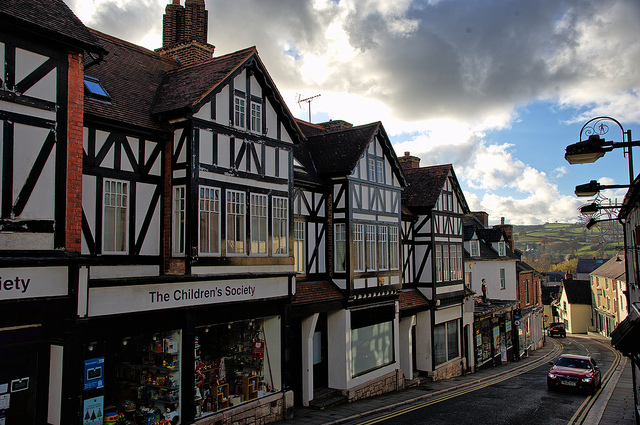
Zeroing in: Old streetlights in towns like Ruthin could soon give way to modern LED luminaries, as Denbighshire takes advantage of a zero percent interest loan from the UK government.
Lux reports: The Welsh county of Denbighshire has landed an interest-free loan from the UK government to upgrade 1,500 of its nearly 12,000 streetlights to LED.
The new lights will will cut about £42,000 annually from Denbighshire’s streetlighting electricity bill, which last year was £385,000 for all 11,790 lights, county council streetlighting engineer Craig Wilson told Lux (other published reports have stated that the bill was £345,000).
Salix lent £280,760 to cover the cost of the luminaires, which the county must pay back from energy savings within eight years, Wilson noted. Denbighshire itself will cover the installation costs.
At zero per cent financing and with significant energy reduction, Denbighshire plans to apply for additional Salix funding to upgrade many of its other old lights in several tranches over the next six years.
It had previously converted about 1,800 to LEDs on ‘principal roads’,
the county said in a press release,, claiming annual savings of £100,000 for those.
The funding comes at a particularly good time because lighting costs have been rising – they jumped by £35,000, or by about 10 per cent, last year alone.
‘With the certainty of increases in electricity tariffs this additional increase would have placed an additional burden on the street lighting budget,’ said Steve Parker, Denbighshire’s Head of Highways and Environmental Services.
‘Any further increases in energy costs would have an adverse effect on the Council’s ability to maintain existing lighting to its current standards,’ he said. ‘That is why we had to consider applying for a large investment, to ensure the sustainability of the service.’
The project includes a control system that allows for intelligent dimming and remote management.
Salix is a UK government entity that typically provides interest-free loans for qualifying public sector energy saving projects including lighting, but which requires a relatively quick payback.
Another government financing group, the
Green Investment Bank, typically allows much longer payback periods but lends money at commercial rates. Its streetlighting programme can extend payments to
as long as 30 years.
Salix is backed by the Department of Energy and Climate Change, the Department for Education, the Higher Education Funding Council for England, the Scottish Government and the Welsh Government.
—
Photo is from Peter F via Flickr
energy efficient financing · led financing · led lighting · led street light · led streetlighting · Novel Energy Lighting
Parrs for the course: Parrs Wood HIgh School has demonstrated significant energy savings from Salix funding. Other schools now stand to gain even more under an enhanced programme.
Lux reports: The UK government entity that provides free loans for green projects has broadened its support for schools, offering an all-in-one programme that funds not just the equipment and installation, but also everything from an initial energy evaluation through training students and teachers how best to conserve energy.
The initiative, from Salix, covers a wide scope of energy-related technologies including LED lighting, computer cooling equipment, hand dryers, boiler replacement and insulation.
Salix will spread £2 million across 40 schools in three tranches. It has already selected the first 13 and hopes to select the next two groups after the summer holidays, a Salix spokesperson told Lux.
‘We are looking for a wide variety of schools including building type and age, geographical location and a mixture of primary, secondary and special schools to ensure the sample is a strong variety,’ the spokesperson said.
The money in this case comes from UK Department for Education. Salix is backed by DfE as well by the Department of Energy and Climate Change, the Higher Education Funding Council for England, the Scottish Government and the Welsh Government.
Salix will require a typical payback period of eight years for the interest-free loans to the schools, although it might lengthen that period in some cases, ‘to ensure a school can implement all technologies identified in order bring them down to best practice and make them an exemplary school in terms of energy use,’ the spokesperson said.
Salix has funded schools’ capital costs previously, but the new programme adds the energy survey and ‘human behaviour’ training for energy reduction. It also includes ‘a document which advises what order to make improvements and to procure against,’ and ‘a financial model to show how to meet the costs.’
Under the former, less comprehensive funding scheme, Parrs Wood High School, a technology college in Manchester, used Salix to fund £10,600 in lighting upgrades and £63,700 on ‘building energy management systems’ (BEMS), leading to 45 per cent savings in lighting, and to 20 per cent and 7 per cent savings on gas and electricity related to the BEMS.
Salix had previously lent Parrs Wood £49,120 for an initial lighting upgrade, leading to annual savings of £13,863.
‘The Salix zero per cent interest loan was the most cost effective way for us to make long term savings and reduce our carbon footprint,’ said Parrs Wood head teacher Andrew Shakos.
Another government entity, the Green Investment Bank, lends money for green projects at commercial interest rates typically allows much longer payback periods. Its streetlighting programme can extend payments to
as long as 30 years.
In a controversial move, the government recently said it plans to sell what could be a majority share in GIB.
energy efficient financing · LED lamps · led lighting · led panels · led tubes · Novel Energy Lighting · salix · salix funding · school led · school lighting
Coming to a Woolworths car park near you: the retailer is planning to roll out its LED lighting scheme to other stores following the massive energy savings it achieved in Coorparoo.
LUX reports: Compared to other conventional lighting solutions, T5 is still seen by some as too efficient for the facilities team to justify upgrading to an LED lighting system. But combined with controls, even the leap from T5 fluorescent lighting to LED can yield significant savings.
Woolworths is a case in point; the retailer’s branch in the South Eastern Brisbane suburb of Coorparoo managed to save 77 per cent energy in its car park area with LEDs and occupation sensors, and earned a Peak Load Reduction Reward for its efforts.
One of the reasons the management was looking for a new solution was the amount of hours the light was on in the car park. The T5 fittings, which had an average life span of two years, were on all day and night, with no control system in place.
The entry to the car part was lit with twin 28W T5 fittings which had been retrofitted in 2012.
When most of the T5s predictably started to fail at the same time, James Dwyer of Jones Lang Lasalle (JLL), which has a national building management contract for Shopping Centres Australia’s 77 retail assets, investigated lighting upgrade options. Dwyer was looking for a solution that would last longer than the T5s and save Woolworths the costs of frequent lamp replacements and maintenance.
The JLL team had recently completed a fire stair and car park lighting upgrade at CP1, a commercial office tower in Brisbane, where LEDs were installed. The positive feedback from the building manager there helped convince Shopping Centres Australia, the owners of Woolworths, that LED was the way forward.
Lighting manufacturer Enlighten helped Dwyer complete an unbudgeted capital expense application and detailed return on investment projection, which ‘impressed the owners and ensured that my application was approved,’ Dwyer said.
Dwyer opted for Enlighten’s Chameleon light fitting, which is built for long-lit areas such as fire stairs, car parks and back of house areas.
No more wasted light

Most of the new LED fittings will only be on when needed, thanks to an in-built motion sensor which instantly switches the light from the standby 8W light output to the full 35W output for a set period of time which can vary between 15 seconds and five minutes. When the set time ends, the light output returns to standby mode.
A 90W 2 module Cetus LED low bay light from Enlighten was installed in the car park entry. This fitting actually represented a net increase in energy consumption compared to the existing T5 fixture (68W including ballast), but it was necessary to improve the light levels in this area.
All lights were replaced on a one for one basis, with each parking bays having a standard 12 chip bulk head installed. The fittings lighting the driveways are permanently on, and the ones approaching a turn have side-emitting optical lenses to ensure good visibility.
An extra incentive
Coorparoo’s Woolworths is located in an area with electricity supply constraints, which means it qualified for a Peak Load Reduction Reward. Energy-saving scheme Energex rewards businesses within the area that contribute to reducing demand on the network during peak periods by replacing lighting with more energy efficient lighting. The reward payment given to Woolworths is estimated to be $500 for this upgrade.
The savings in numbers
The new LED lighting will save an estimated 77per cent energy in the car park area, which equates to 30,504 kWh per year. The project capital cost was $21,250 after the incentive payment, with a project payback calculation from energy and maintenance savings of 2.7 years.
According to Dwyer, the project has been well received. ‘The Chamaeleon fitting is perfectly suited to our undercover car park operation and I have received an immense amount of positive feedback from the tenants,’ he said.
Dwyer is planning to retrofit another shopping centre’s undercover carpark lighting with in early 2015.
Novel Energy Lighting specialises in
LED Tubes, and
LED IP65 fittings for business lighting retrofits. Speak to us today to understand the energy savings and
explore financing which can be repaid through the energy cost savings.
commercial lighting · energy efficient financing · led batten · led ip65 · LED lamps · led lighting · LED retrofit · led tubes · Novel Energy Lighting

 Most of the new LED fittings will only be on when needed, thanks to an in-built motion sensor which instantly switches the light from the standby 8W light output to the full 35W output for a set period of time which can vary between 15 seconds and five minutes. When the set time ends, the light output returns to standby mode.
Most of the new LED fittings will only be on when needed, thanks to an in-built motion sensor which instantly switches the light from the standby 8W light output to the full 35W output for a set period of time which can vary between 15 seconds and five minutes. When the set time ends, the light output returns to standby mode.



